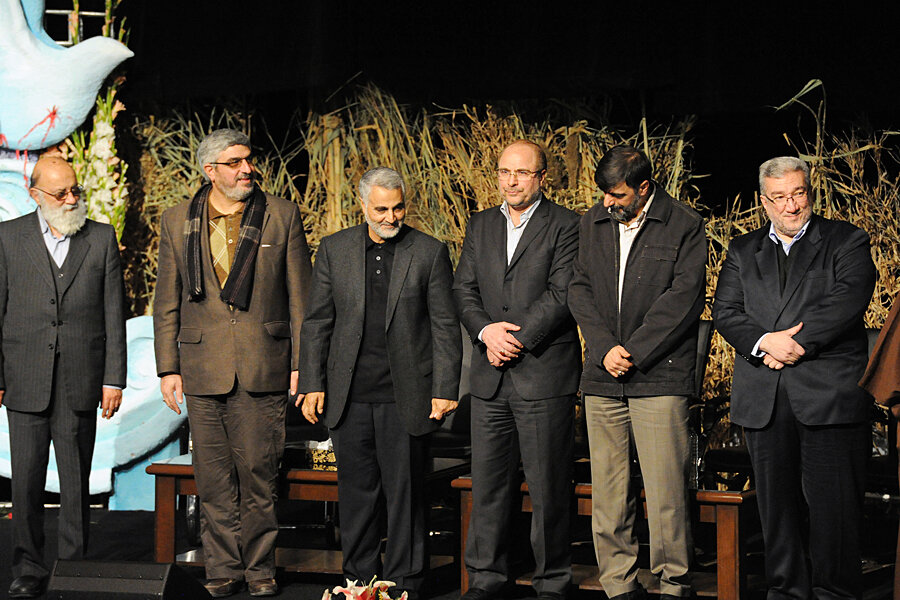Among Iran's 'True Believers,' an enduring faith in martyrdom
Loading...
| Tehran, Iran
The commander of Iran’s enigmatic Qods Force did not speak.
But the mere presence of Maj. Gen. Qassem Soleimani at a memorial last night – gray-haired and scarred after decades of battling American and Israeli foes and building up Iran’s influence in the region – speaks volumes about Iran’s continued commitment to the time-worn theme of martyrdom and its lessons in war.
Maj. Gen. Soleimani joined clerics, martyr families, and fellow officers of the Qods Force, the Revolutionary Guard branch that handles overseas operations – from supplying missiles for Hezbollah to alleged bomb plots – to mark a year since the death of one of their own in Syria.
Hardliners may no longer dominate Iranian politics after the surprise election victory of centrist President Hassan Rouhani last year, but the official language of martyrdom has not changed for Iran’s "True Believers."
“Today, if we can stand firm against the US and the excessive demands of the US, it is because of the culture of martyrdom and culture of jihad,” said Mohammad Baqer Qalibaf, the Tehran mayor and two-time conservative presidential candidate, from the podium. “If we, God forbid, forget this culture, we will lose our dignity…. We will never give our dignity to the enemy.”
Soleimani buried his face in his right hand and some in the audience wept as a religious storyteller recounted the 7th-century death of Imam Hossein, the “Lord of the Martyrs.” For Shiites, this death signifies resistance armed with faith against overwhelming odds. That history of self-sacrifice, bound to a minority branch of Islam defined by centuries of persecution, was the ideological and political bedrock of Iran's 1979 Islamic revolution, which marks its 35th anniversary on Feb. 11.
Soleimani is credited with turning Lebanon’s Shiite militant organization Hezbollah into one of the most potent fighting forces in the Middle East; wielding low-profile but effective pressure for years on US forces in Iraq; and coming to the rescue of Syrian ally President Bashar al-Assad in that country's civil war.
Last night, wearing a dark gray suit jacket instead of his usual Guard uniform, Soleimani reluctantly took to the stage after being asked three times to help present an award to family members of Hassan Shateri, a Qods Force general killed in Syria last year.
Though Soleimani kept his silence, speaker after speaker used Mr. Shateri’s nickname and praised “Engineer Hessam” or “Hajj Hessam” as a fighter of the 1980s Iran-Iraq war, as a road builder in Afghanistan, and as the man tasked with commanding Iranian efforts to help Hezbollah rebuild southern Lebanon after its 2006 war with Israel. He was killed when his car was shot up on a highway in Syria.
Iran’s martyrs “brought our freedom and humanity under the shadow of Islam,” Mr. Qalibaf told the audience, and its revolution had shaken “all countries in the world” because its far-reaching impact had invigorated “political Islam.”
The eulogy was delivered at an auditorium inside a sprawling new complex called the Museum of Holy Defense and Spreading the Culture of Resistance. Inside, the columns were decorated with shiny tin-plated AK-47 assault rifles, with yellow plastic tulips stuck in each barrel.
Outside, life-size replicas of each of Iran’s ballistic missile designs are lined up on a hillside and old tanks and military vehicles line the roads. Also on display are several wrecked vehicles in which four of Iran’s nuclear scientists were assassinated in recent years, often with so-called “sticky bombs” attached while stuck in traffic in Tehran.
It is against this backdrop of a years-long covert war between the US, Israel, and Persian Gulf allies on one side, and Iran, Hezbollah, and their “axis of resistance” on the other, that Iran marks the regime’s 35th anniversary, highlighting scientific achievements despite sanctions and outside “pressure." Officials often attribute the triumph to martyr ideology.
While many across Iran's political divide respect the martyrs – the "nuclear martyrs" especially resonate – the number of True Believers who adhere most closely to this ideology remain a minority, albeit a powerful one. President Rouhani won more votes than all of his conservative and hardline challengers combined with a campaign promise to "end extremism" and embrace moderation.
Shateri’s sacrifice and commitment to resistance should serve as a warning to those who “threaten” Iran and its nuclear program, speakers said at Thursday's ceremony. “If the enemy understands people like Hajj Hesam [Shateri] in the right way, it can affect the decisions of the US and Israel,” said Ahmed-Reza Radan, Iran’s deputy police chief.
Such statements resonated with the women seated in the audience; most wore black chadors that leave just more than a triangle of the face visible. Although Iranian women are rarely martyrs themselves, many appear to have internalized the ideology.
“When Obama says that ‘all options are on the table,’ he should know that we have options too: [the example of] our martyrs,” says Afrouz Rahmani, one of the women in attendance.
Were they impressed that such high-level officials as Soleimani and Qalibaf were on hand? “It wasn’t the first time they came. They are always amongst us,” says another, who gave her family name as Sedghi.








